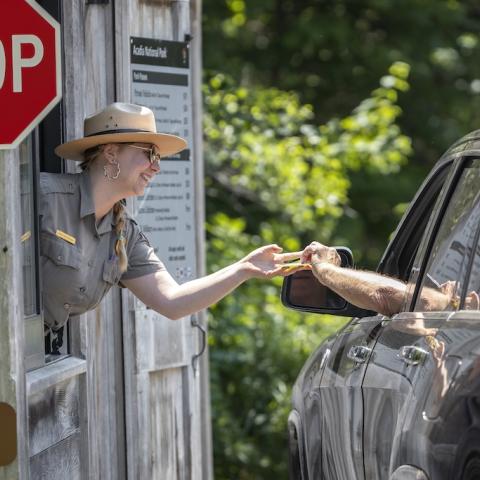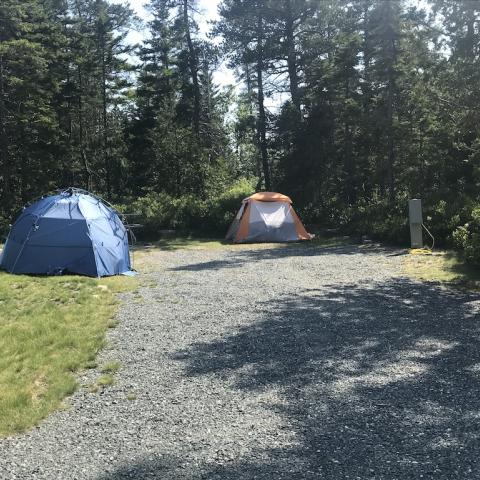
Acadia National Park staff is grappling with how to manage crowds, and whether local residents should be given preference over vacationers/AcadiaOnMyMind.com
As discussion into how to handle soaring crowds to the National Park System is beginning to turn into planning, one user group -- local residents -- is wondering how it will be affected by the resulting approach to overcrowding.
As officials at Acadia and Zion national parks delve into how best to manage record-breaking crowds, some residents living near, and in the case of Acadia surrounded by the park, are voicing the belief that they should be treated differently than visitors from afar when it comes to access those parks.
"Remember that local residents also consider this home, as well as a national park,” read one comment made on preliminary concepts outlined in Acadia's developing transportation plan.
Across the country, in Utah, Trace Westcott, of Kanab, Utah, regarding Traveler's story about Zion's proposals to require reservations to visit, suggested, "How about lobbying for an exemption for locals? I can also see this could potentially hurt local business in some ways not yet revealed."
Similar comments no doubt would be voiced if parks such as Yellowstone, Glacier, Yosemite, Grand Canyon, Sequoia, Shenandoah and countless others suggested a need for reservation systems to manage crowds.
“It’s hard to categorize visitors that way (local and vacationers), because in the end they're all equal to the park when they come visit," John Kelly, Acadia's management assistant, told the Traveler on Wednesday. "But there certainly are different patterns for locals who are using the park like a backyard, something that they can access readily at times that they choose. ... The park is so integrated into the communities that it very much is the backyard of some peoples’ homes. So when it comes down to accessing the park and using the park, there is a certain sense of ownership and love of the park that is different from someone who has come from away.”
Like many national parks across the country, visitors flock to Acadia in ever growing crowds, at some times diminishing the experience due to congestion on roadways and crowds at popular sites in the coastal Maine park. Park officials are developing a traffic management plan that could dramatically overhaul how visitors see Acadia. In addition to reservations and quotas, the park could introduce a concession-run bus operation (ending tour bus service), expand public transit, change the direction that traffic flows, and build new parking lots. The park is also trying to improve safety and reduce conflicts among different user groups, such as cars, tour buses, cyclists, and pedestrians.
Those concepts were floated as discussion starters, and generated more than 200 individual comments, with a strong majority (163) submitted by Maine residents.
In general, according to a park analysis of those comments, park users agree that "the current condition of parking is not sustainable because of user conflicts, too few parking spaces, and poor surfacing."
However, the analysis continued, those who commented weren't unanimous in their proposed solutions.
"Commenters argue for increased parking lot size and quantity, improved circulation within parking lots, restrictions on parking access or vehicle size, improved pull-off parking and right-lane parking, and improved access to trails, visitor centers, and bus stops from parking locations. As stated by a commenter, 'Motorists in all types of vehicles, large and small, struggle to find adequate space to park, frequently parking inappropriately on the rocks, straddling the curbing, in commercial vehicle locations or well beyond the limits of marked parking spaces, further impeding traffic circulation and endangering the well-being of pedestrians.'”
With the bulk of the park located on Mount Desert Island, many comments were directed at that area and congestion.
"Primarily, commenters were clear that they did not want parking lots to close. Rather, they wished to see better access to trails, visitor centers, facilities, and public transit from parking lots. However, there was disagreement on whether to remove or reduce right-lane parking. Many commenters in favor of removing right lane parking noted that it should be accompanied with an increase in public transportation or increased pull-out parking elsewhere," the analysis showed. "Others hoped to see the existing right-lane parking turned into a bike/ped lane. Those in opposition to removing right-lane parking explained that only three miles of nine available right-hand parking is used; thus, a reduction in or removal of those parking spaces is not necessary. Overall, with regard to informal parking areas, commenters were in agreement that such parking spaces need to be addressed. Commenters find informal pull-off spaces to be a safety hazard. They suggest formalizing and improving access to these parking areas. If parking restrictions are put into force, commenters wish to see increased public transportation and suggest only restricting parking when necessary and not during the entire year."
Mr. Kelly said Wednesday that, when it comes to local residents, exactly how to deal with their concerns over access is a difficult question that Acadia staff is trying to answer. However, he did indicate that it might be necessary to implement a reservation system for some highly popular areas of the park, though there won't be a blanket reservation system to visit the park.
“We are already at the point where we know we will not have any types of limits on pedestrians or bikes,” he said, adding, however, that limits could be coming for private and commercial tours of the parks.
"Overall, commenters agreed that tour buses are good for the park because it reduces private vehicles," the park's review of comments found. "They especially enjoy open-air tour buses. However, many commenters believed that there are too many large tour buses that conflict with personal vehicles, and that this scenario creates congestion."
Interestingly, one of the comments suggested that the park close the Jordon Pond House, a highlight of many visitors' park experiences where they can dine over lobster or take a mid-afternoon snack of jam-covered popovers and tea with sublime views of the pond and surrounding landscape.
“The tradition of the Jordan Pond House has always been a memorable Acadia experience. Because of overcrowding, this particular unique visitor experience has been greatly diminished," the individual wrote. "I would like to recommend the closing of the Jordan Pond House, transforming it into the new Acadia National Park Natural Science and History Education Center.”
Another suggested the park stop advertising the Schoodic Peninsula as the "quiet side of the park," as such advertising could lead to that area becoming overcrowded.




 Support Essential Coverage of Essential Places
Support Essential Coverage of Essential Places







Comments
I think if locals can get preference *on weekends* that could help? Vacationers are on vacation so should be able to come on a week day. Locals could be defined as anyone within about 100 miles? I've seen that some parks have instiuted parking reservations (Yosemite I think?). Locals should know about the hidden gems already so will hopefully go there instead of the more famous attractions? Managing this are hard decisions to make. I live here for the nature, including the National Parks. But I also plan my travel around visiting other National Parks!
I think locals should get preference only if there is some reason to believe that they contribute less to crowding and ecological damage than someone from farther away.
We visited Acadia during the busy July 4 weekend, and while we don't live near the park, we know it well enough from our blogging and writing hiking guides, that we were able to avoid the traffic and crowds. Seems that locals would know how to avoid the crowds, as would park visitors who take the time to learn what to avoid, and when.
It seems that some of the measures being considered by the park, such as the car reservation system, don't have to be overly restrictive. Then locals can still have a sense of being able to drop into their own backyard whenever they want.
Thanks for linking to our recent blog post about the traffic in Acadia during the July 4 weekend in this article, Kurt. Your readers may also be interested in this other blog post, "7 ways for a stress-free visit to Acadia National Park."
https://acadiaonmymind.com/2017/05/7-ways-stress-free-visit-acadia-natio...
I live an hour and a half from Paradise on Mt. Rainier, as do several hundred thousand other people. When Rainier experienced the floods of 2006 that essentially closed the park for more than six months, I felt compelled to drive up to the Nisqually Entrance to take the ranger-led walk up the road to see some of the damage. I told the ranger that I had needed to come up and make sure my mountain was okay. He laughed and said he'd heard similar comments dozens of times in the weeks since he'd started conducting those walks.
All of us who live near national parks feel possessive of them, I think (and if you don't then I have to suspect your sanity). I'm not sure that should give us locals rights that other Americans do not have to these places.
I do very strongly feel, though, that we as Americans have far more rights to our parks than do citizens of other countries. And that we have fewer rights to parks in other countries than the citizens of those countries have to their parks.
where is this right to bar foreigners from the Parks found in the Constitution? Good luck getting anyone with more than 2 weeks of legal training to enforce it
This is amazing. When I visited Acadia in May 2008 visitors were about 2% of what we see here. It seems to me that there should be a national task force looking at this with reps from the parks that are most under stress from visitors. I think three things caused this: Good economy, cheap gas, and the Ken Burns series. Also, the pioneers of national parks never envisioned the population growth and ease of transportation 100 years after the founding of the system.
Acadia could definitely use some more parking. For example, there are trailheads for major trails with parking for less than a quarter of people who want to use the trail on a busy day. So then people end up parking wherever they can in non ideal spots. The park itself, other than Cadillac Mountain doesn't seem overcrowded. Additional parking would be a great improvement.
Regarding the comment on Jordan House, it is busy, but not unbearably so. How about adding a second restaurant on one of the other lakes to help generate more income for the park and spread the visitors out.
My family and I were just in Acadia 3 days ago, it was crowded but very manageable and we had a great time. The right lane parking worked out well, to me any restrictions on out of state visitors would be very unfair and are not needed. We went to cadillac mountain twice over two days, during the day and at night, thunder hole, otter point, and did some of the trails, lots of people but it was pretty organized.